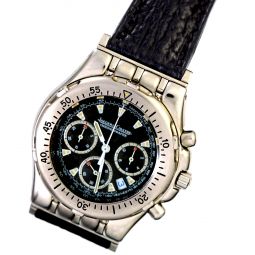Tudor Big Block Model 79170 Round Button Chronograph
ITEM-1867

Product Details
TUDOR PRINCE OYSTERDATE “BIG BLOCK” 79170
This example of the 79170 chronograph produced in 1992 was the successor to 9421/0 with a rotatable bezel and retained from its ancestor the thicker case which earned it the nickname “Big Block”. Its Oyster bracelet in steel was no longer signed Rolex, but TUDOR – although it still had the same 78360 reference number.
Details:
MAKE
Manufacturer: Tudor
Model: Big Block 79170
Country: Switzerland
Type: Man's
Circa Date: 1992
CASE
Material: Stainless Steel.
Measurements: The width is 40 mm without crown.
Shape: Round.
Back: Oyster back.
Reference #: B442204
Conditions: C 3
(The case is in Very Good condition)
BAND
Type: Link bracelet band.
Measurements: Measures 7-3/4" in length.
DIAL
Color: Black.
Numerals: Non-numeric Hour Markers.
Indices: Minute Track, 1/5-seconds, subsidiary seconds dial, 30-minute
register, 12-hour register.
Hands: Baton Hands.
Conditions: D 2
(The dial is in Perfect condition)
MOVEMENT
Type: Mechanical, automatic wind movement.
Jewels: 25 Jewels.
Escapement: Lever Escapement.
Set: Stem Set.
Conditions: M 3
(The movement is in Very Good condition)
In 1976, TUDOR presented a new family of products which constituted a small revolution for the brand. Indeed, these new Prince Oysterdate watches were the first chronographs in the history of TUDOR to be equipped with self-winding movements. Listed under the name Prince Oysterdate, they were also known by the names “AUTOMATIC CHRONO TIME” or “CHRONO TIME” referring to the signatures displayed on their dials. While their cases retained the general lines of the previous families, they became thicker to accommodate the rotor of the self-winding movement, which earned them the nickname “Big Block” in collectors’ circles. The name “Big Block” endured in the following 79100 series introduced in 1989, which featured only minimal modifications. Like preceding generations, the 9400 series consists of three references distinguished one from the other by their type of bezel, a feature that is also present on the “Big Block” models of the 79100 series. Likewise, several dial variations were available under the same reference number. Two aesthetic trends characterize them: one freely inspired by the spirit of the dials of the previous two series, sometimes called “Exotic” by collectors; the other, much more illustrated in the catalogue, emphasizing a significant dial-counter contrast with black and white or sliver and white combinations. The movement at the heart of these new chronographs was the Valjoux Calibre 7750. Having the same diameter as the manually wound Valjoux 234, 30.4 mm or 13 lines, it was 1.5 mm thicker than the latter and had a frequency of 28,800 beats per hour. Its chronograph mechanism was a highly reliable cam and oscillating pinion system. The architecture of this new movement brought about a reorganisation of the dial with the addition of an hour counter, the transfer of the group of counters towards the left of the dial, and the relocation of the date aperture to 3 o’clock.

